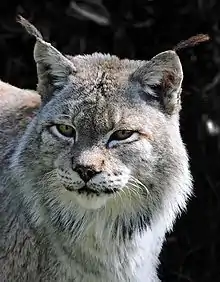| Siberian lynx | |
|---|---|
 | |
| A Siberian lynx at Dartmoor Zoological Park, England. | |
| Scientific classification | |
| Domain: | Eukaryota |
| Kingdom: | Animalia |
| Phylum: | Chordata |
| Class: | Mammalia |
| Order: | Carnivora |
| Suborder: | Feliformia |
| Family: | Felidae |
| Subfamily: | Felinae |
| Genus: | Lynx |
| Species: | |
| Subspecies: | L. l. wrangeli |
| Trinomial name | |
| Lynx lynx wrangeli (Ognev, 1928) | |
| Synonyms | |
|
Lynx lynx cervaria | |
The Siberian lynx (Lynx lynx wrangeli), also known as the East Siberian lynx, is a subspecies of Eurasian lynx living in the Russian Far East, Korea, Mongolia, and China (Machuria and eastern Inner Mongolia). It lives in the Stanovoy Range and east of the Yenisei River. There were 5,890 mature individuals in the Russian Far East as of 2013.[1] Prey include the Siberian roe deer.[2] The Siberian lynx is the second most common subspecies of the Eurasian lynx. According to a study done on the mortality of Eurasian lynx, the Siberian lynx lives to an average age of 15 years.[3]
See also
References
- ↑ Breitenmoser, U.; Breitenmoser-Würsten, C.; Lanz, T.; von Arx, M.; Antonevich, A.; Bao, W. & Avgan, B. (2015). "Lynx lynx". IUCN Red List of Threatened Species. 2015: e.T12519A121707666. Retrieved 15 January 2018.
- ↑ Heptner, V. G.; Sludskij, A. A. (1992) [1972]. "Lynx". Mlekopitajuščie Sovetskogo Soiuza. Moskva: Vysšaia Škola [Mammals of the Soviet Union. Volume II, Part 2. Carnivora (Hyaenas and Cats)]. Washington DC: Smithsonian Institution and the National Science Foundation. pp. 524–636.
- ↑ Heaver, J, Waters, M. A retrospective study of mortality in Eurasian lynx (Lynx lynx) in UK zoos. Zoo Biology. 2019; 38: 200– 208. doi:10.1002/zoo.21476
This article is issued from Wikipedia. The text is licensed under Creative Commons - Attribution - Sharealike. Additional terms may apply for the media files.